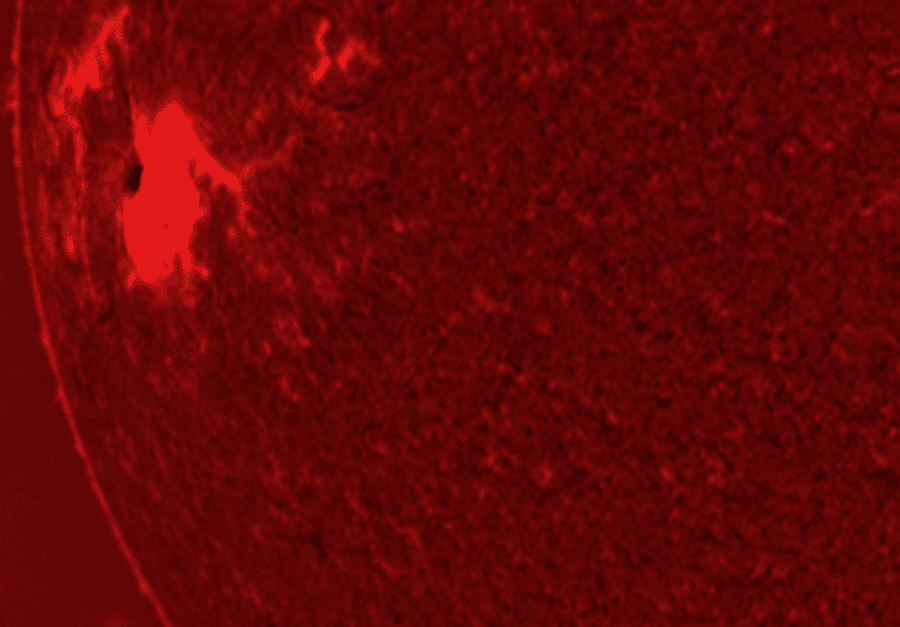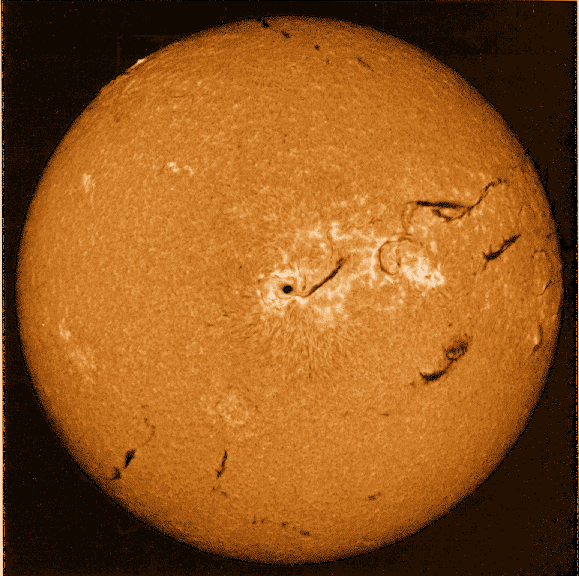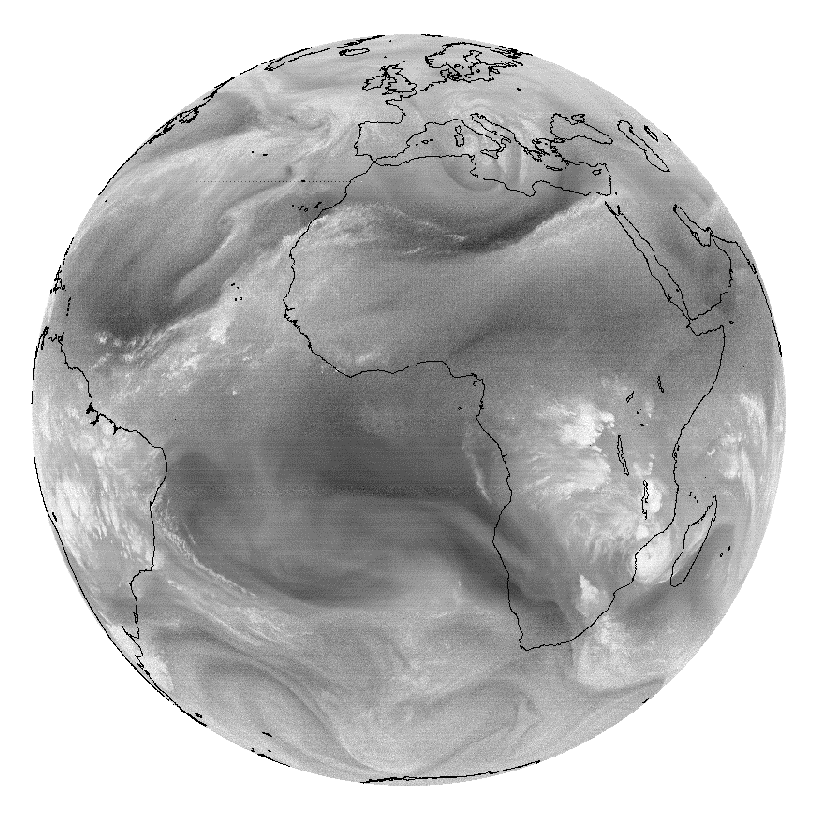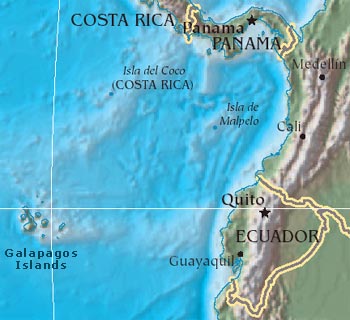Page 1 of 2
APOD: A Large Tsunami Shock Wave on the Sun (2011 Sep 25)
Posted: Sun Sep 25, 2011 4:07 am
by APOD Robot
 A Large Tsunami Shock Wave on the Sun
Explanation:
A Large Tsunami Shock Wave on the Sun
Explanation: Tsunamis this large don't happen on Earth. During 2006, a large solar flare from an Earth-sized
sunspot produced a
tsunami-type shock wave that was spectacular even for the Sun.
Pictured above, the
tsunami wave was captured moving out from active region AR 10930 by the
Optical Solar Patrol Network (OSPAN) telescope in
New Mexico,
USA. The resulting
shock wave, known technically as a
Moreton wave, compressed and heated up gasses including
hydrogen in the
photosphere of the Sun, causing a momentarily brighter glow. The
above image was taken in a
very specific red color emitted exclusively by hydrogen gas. The
rampaging tsunami took out some active
filaments on the Sun, although many re-established themselves later. The
solar tsunami spread at nearly one million kilometers per hour, and circled the entire
Sun in a matter of minutes.
[/b]
Re: APOD: A Large Tsunami Shock Wave on the Sun (2011 Sep 25
Posted: Sun Sep 25, 2011 4:54 am
by Beyond
The -Hydrogen- and the -above link- are broke. I guess they couldn't take all those Tsunami's.

Re: APOD: A Large Tsunami Shock Wave on the Sun (2011 Sep 25
Posted: Sun Sep 25, 2011 5:35 am
by bystander
Fixed, to the best of my abilities.
Re: APOD: A Large Tsunami Shock Wave on the Sun (2011 Sep 25
Posted: Sun Sep 25, 2011 6:21 am
by Beyond
bystander wrote:Fixed, to the best of my abilities.
The description says the -above image- was taken in a very specific red color, but the image is grey. I don't mean to be picky,
yes i dobut grey is not any shade of red that i am aware of.
Re: APOD: A Large Tsunami Shock Wave on the Sun (2011 Sep 25
Posted: Sun Sep 25, 2011 8:22 am
by Ann
Beyond wrote:bystander wrote:Fixed, to the best of my abilities.
The description says the -above image- was taken in a very specific red color, but the image is grey. I don't mean to be picky,
yes i dobut grey is not any shade of red that i am aware of.
Ah, Beyond, I sympathize! You're disappointed when something that is really red isn't being shown as red...
and you know what I think when something that is really blue isn't being shown as blue...
Anyway. The specific red color that is detected, but not shown, in today's APOD is hydrogen alpha, 656 nm. That is a surprisingly dark red color, not traffic-light red at all.
In this picture, you can see three filters, one that is the color of hydrogen alpha (the top left one), one that is the color of ionized sulphur (the bottom left one - isn't it remarkably dark?) and one that is the color of doubly ionized oxygen, the blue-green one at right.
The thing to remember is that today's APOD isn't an RGB image, and it isn't any sort of three-color image at all. It's a monochromatic image. Such images are almost always shown as black and white.
Can't resist showing you this image from the Olympic Games in Stockholm back in 1912. Back then, photography was always black and white, unless the images were hand-colored afterwards. But interestingly, back then the photographic plates were sensitive mostly to blue and ultraviolet light.
Take a look at the flags here! Two of them seem to have dark crosses on a light background. In reality, it's the other way round. These are Swedish flags, so the crosses are yellow, and the background fields are a sort of royal blue. Since the photographic plates back then reacted strongly to blue light, the royal blue fields look very light. But the yellow crosses emit barely any blue light at all, and therefore they look dark!
So my point is that you can't really expect a monochromatic hydrogen alpha to look red. But if you want it to be "true-color", the hydrogen alpha filter in the picture above shows you what shade of red it would be!
Ann
Re: APOD: A Large Tsunami Shock Wave on the Sun (2011 Sep 25
Posted: Sun Sep 25, 2011 9:07 am
by Ann
Color aside, today's APOD is interesting, and it underscores the similarity between phenomena of incredibly different scales. Imagine that a tsunami on the Earth is slightly similar to a huge wave on the "surface" on the Sun. And the "tsunami" on the Sun is generated by a sort of "sunquake", just like an earthly tsunami is generated by an earthquake.
I'm a math illiterate, and I'm trying to figure out how much bigger the "surface" of the Sun is compared with the surface of the Earth. The diameter of the Sun is about a hundred times larger than the diameter of the Earth. Can anyone tell me how much bigger does that make the surface of the Sun, compared with the surface ot the Earth? (So that I don't have to look it up myself?)
Ann
Re: APOD: A Large Tsunami Shock Wave on the Sun (2011 Sep 25
Posted: Sun Sep 25, 2011 10:20 am
by JohnD
That demonstrates the consequences but not what started it.
The shock wave seems to originat from a suddenly cooler spot in the sunspot, as an area of black waxes and wanes.
What happened?
John
Re: APOD: A Large Tsunami Shock Wave on the Sun (2011 Sep 25
Posted: Sun Sep 25, 2011 12:15 pm
by orin stepanek
APOD Robot wrote: The
solar tsunami spread at nearly one million kilometers per hour, and circled the entire
Sun in a matter of minutes.
Wow! That's about 278 kilometers per second. It's hard to imagine that kind of speed!

Re: APOD: A Large Tsunami Shock Wave on the Sun (2011 Sep 25
Posted: Sun Sep 25, 2011 1:25 pm
by nstahl
Ann, once again a relevant and informative reply. Thank you.
Area scales as the square of radius or diameter (in general, length) so if the diameter of the sun is 100 times earth's, the area is 10,000 times earth's.
Re: APOD: A Large Tsunami Shock Wave on the Sun (2011 Sep 25
Posted: Sun Sep 25, 2011 1:31 pm
by rstevenson
Ann wrote:... I'm a math illiterate, and I'm trying to figure out how much bigger the "surface" of the Sun is compared with the surface of the Earth. The diameter of the Sun is about a hundred times larger than the diameter of the Earth. Can anyone tell me how much bigger does that make the surface of the Sun, compared with the surface ot the Earth? (So that I don't have to look it up myself?)
From the site
smartconversion.com...
Surface area of the Sun: 6.088 x 10
12 km
2
Surface area of the Earth: 5.100656 x 10
8 km
2
If I correctly punched those numbers into my handy dandy calculator, that makes the Sun's surface area about 11,936 times larger than the Earth's.
Or, to make it graphical, as a pixelator should...

- area.jpg (4.3 KiB) Viewed 11067 times
The area of the (traditionally coloured

) Sun is represented by the square, and the small blue dot near the middle represents the area of the Earth to the same scale.
Rob
Re: APOD: A Large Tsunami Shock Wave on the Sun (2011 Sep 25
Posted: Sun Sep 25, 2011 1:37 pm
by NoelC
Wow, something so particularly violent so as to be noticed on the surface of what is essentially a runaway nuclear reaction already... Impressive!
-Noel
Re: APOD: A Large Tsunami Shock Wave on the Sun (2011 Sep 25
Posted: Sun Sep 25, 2011 1:43 pm
by NoelC
Beyond wrote:but the image is grey. I don't mean to be picky,yes i dobut grey is not any shade of red that i am aware of.
Here you go, Beyond. This should help visualize the filter color used a bit better (you may have to refresh or click on this to see the animation)...

-Noel
Re: APOD: A Large Tsunami Shock Wave on the Sun (2011 Sep 25
Posted: Sun Sep 25, 2011 1:49 pm
by neufer
So what does this have to do with
the photosphere of the Sun

One can't even observe
the photosphere in opaque Hα light.
(And it is really more like a sonic boom than a tsunami.)
Re: APOD: A Large Tsunami Shock Wave on the Sun (2011 Sep 25
Posted: Sun Sep 25, 2011 1:55 pm
by NoelC
One can't even observe the photosphere in opaque Hα light.
Not sure I agree with or understand what you're saying, Neufer...
First off, isn't the photosphere of the sun a wideband light source? If so, it must certainly be emitting at least some light in the 656 nm wavelength.
Secondly, what do you mean by "opaque Hα light"? Those words don't seem to go together.
-Noel
Re: APOD: A Large Tsunami Shock Wave on the Sun (2011 Sep 25
Posted: Sun Sep 25, 2011 3:36 pm
by neufer
NoelC wrote:
One can't even observe the photosphere in opaque Hα light.
Not sure I agree with or understand what you're saying, Neufer...
First off, isn't the photosphere of the sun a wideband light source? If so, it must certainly be emitting at least some light in the 656 nm wavelength.
The sun is indeed a wideband photospheric light source
with the exception
of numerous narrow dark chromospheric
Fraunhofer lines including the
red 656.281nm Hα line.
While the (~5800 K) photosphere also radiates
red 656.281nm Hα line that photospheric radiation
is all absorbed by the chromosphere which then re-radiates its own
red 656.281nm Hα line
in accordance with its own (
mostly colder ~ 4500K) temperatures.
It is only these colder darker chromospheric
Fraunhofer lines that we can observe.
NoelC wrote:
Secondly, what do you mean by "opaque Hα light"? Those words don't seem to go together.
"Opaque Hα light" makes about as much sense as "blackbody radiation" does...i.e., all the sense in the world.
Absorption & radiation are really two sides of the same coin.
Transparent objects are invisible not only because they do not absorb (or scatter) light
but also because they are incapable of re-radiating their own light.
One can see opaque (non-transparent) objects not only because such objects
intercept the light behind them (and/or scatter some of the light landing on them)
but because re-radiate light out according to their own unique temperature.
Re: APOD: A Large Tsunami Shock Wave on the Sun (2011 Sep 25
Posted: Sun Sep 25, 2011 4:12 pm
by Beyond
Thanks Ann & NoelC for the explanations. So i take it then, at least in the case of today's APOD, that a red filter was used as the best way to pick up the detail of the shock wave, but because only one filter was used, the picture looks like black & white, or grey.
So, NoelC, did you add the color so i could see what the picture description said, even though it wouldn't normally actually be visible that way?
The animation worked well as i came to it.
To us non-scientific, non-photographer types, some pretty strange things go on in the astrophotography department. That's why we usually just look at the pretty pictures and let it go at that. For me to get much deeper into anything, would result in my face being covered with the Egg Nebula.

Re: APOD: A Large Tsunami Shock Wave on the Sun (2011 Sep 25
Posted: Sun Sep 25, 2011 4:25 pm
by Nantee
orin stepanek wrote:APOD Robot wrote: The
solar tsunami spread at nearly one million kilometers per hour, and circled the entire
Sun in a matter of minutes.
Wow! That's about 278 kilometers per second. It's hard to imagine that kind of speed!

Wow, for what effectively is a sound wave to travel that fast, what would the density of the photosphere need to be? I'm thinking that since the speed of sound in air at sea level is roughly 340 m/s, that makes the density of the photosphere roughly 800 times denser than the air we breathe.
But there must be something wrong with my 800x density figure, because density of air at room temp is roughly 0.0012g/cm
3. Multiply that by 1400 makes the density of the photosphere 1g/cm
3, which is as dense as water. And the speed of sound in water is roughly 1.5 km/s. I guess density and the speed of sound isn't a sort of linear relationship?
Re: APOD: A Large Tsunami Shock Wave on the Sun (2011 Sep 25
Posted: Sun Sep 25, 2011 4:27 pm
by Nantee
Oops, sorry, make that "1400" in the second paragraph "800". But it doesn't really help my figures or understanding.
Re: APOD: A Large Tsunami Shock Wave on the Sun (2011 Sep 25
Posted: Sun Sep 25, 2011 5:28 pm
by RJN
Cool image! Can you tell me where you found it? Which satellite took this image?
Was it a GOES like this APOD:
http://apod.nasa.gov/apod/ap020323.html ?
Thanks for any help you can be.
- RJN
Re: APOD: A Large Tsunami Shock Wave on the Sun (2011 Sep 25
Posted: Sun Sep 25, 2011 6:12 pm
by bystander
RJN wrote:Cool image! Can you tell me where you found it? Which satellite took this image?
Was it a GOES like this APOD:
http://apod.nasa.gov/apod/ap020323.html ?
Thanks for any help you can be.
- RJN
I seems to be an image from METEOSAT-9 (eumetsat.int) (ESA Version of GOES)
http://astrobob.areavoices.com/2011/03/ ... s-and-ice/
Re: APOD: A Large Tsunami Shock Wave on the Sun (2011 Sep 25
Posted: Sun Sep 25, 2011 7:49 pm
by neufer
Bystander is right, as usual.
It was snitched from astrobob's website:
http://astrobob.areavoices.com/2011/03/ ... s-and-ice/
GOES hemispheric water vapor maps invariably have a pronounced
dark subtropical high dry spot south of the Galapagos:
It should be noted that these water vapor depictions (like many astronomy photographs) are actually
photo-negatives with the dark dry spots representing the regions of brightest infrared radiation.
This is in line with the traditional procedure of
always having white (rather than black) clouds
although clouds do not radiate much infrared radiation radiation (and, hence, should be black).
H-alpha pictures of the sun are normal photo-positives with the hottest most radiant regions being the brightest.
Since the vertical temperature lapse rate in the chromosphere is negative, however, bright regions
in both generally represent local topographical 'mountains' of gas (water vapor or hydrogen respectively).
Re: APOD: A Large Tsunami Shock Wave on the Sun (2011 Sep 25
Posted: Sun Sep 25, 2011 8:59 pm
by NoelC
First, thanks very much to Neufer for the enhanced descriptions of what we're observing on the sun.
Beyond wrote:So, NoelC, did you add the color so i could see what the picture description said, even though it wouldn't normally actually be visible that way?
The reason the image is shown in grayscale is that the imager behind the Ha filter just reads out luminance measurements and these are being presented as pixel values with Red = Green = Blue values - e.g., grayscale.
I loaded the grayscale animated GIF into Photoshop, applied a 100% density red photo filter layer to all frames, set the animation to repeat forever, and saved it back out. This yields pixel values of luminance in the Red channel only, with Green = 0 and Blue = 0.
What I posted was much like what you'd see with a
color camera mounted behind a deep red Ha filter.
Since the red color of your display no doubt has a wider bandwidth than the deep red of a narrowband Ha filter, what I've done is still not quite what you'd perceive if looking through an Ha filter (along with some attenuation as well so you didn't burn your eyes), but it is closer than grayscale.
If you ever get the chance to observe the sun through a good solar telescope with an Ha filter, make sure to do so.
-Noel
Re: APOD: A Large Tsunami Shock Wave on the Sun (2011 Sep 25
Posted: Sun Sep 25, 2011 9:21 pm
by neufer
Nantee wrote:orin stepanek wrote:APOD Robot wrote:
The
solar tsunami spread at nearly one million kilometers per hour, and circled the entire
Sun in a matter of minutes.
Wow! That's about 278 kilometers per second. It's hard to imagine that kind of speed!

Wow, for what effectively is a sound wave to travel that fast, what would the density of the photosphere need to be? I'm thinking that since the speed of sound in air at sea level is roughly 340 m/s, that makes the density of the photosphere roughly 800 times denser than the air we breathe.
Firstly,
these are coronal waves impinging upon the chromosphere...it has NOTHING to do with the photosphere.
The speed of sound in a gas is roughly equivalent to speed of the average the gas molecule (which is proportional to the square root of the temperature divided by the mass of the gas molecule). The corona is ~4,000 times hotter than the earth's troposphere and its molecules are ~30 lighter than those of the earth's troposphere so one would expect sound velocities ~ sqrt(4,000 x 30) ~ 350 times faster in the corona than in the earth's troposphere. (We are really dealing with magnetohydrodynamics here, however, so this is just "ballpark.")
Nantee wrote:
But there must be something wrong with my 800x density figure, because density of air at room temp is roughly 0.0012g/cm3. Multiply that by 1400 makes the density of the photosphere 1g/cm3, which is as dense as water. And the speed of sound in water is roughly 1.5 km/s. I guess density and the speed of sound isn't a sort of linear relationship?
The speed of sound in a liquid or solid where the molecules are packed virtually "shoulder to shoulder" depends directly upon the compressibility of the liquid or solid and has little to do with the speed of sound in a gas.
All things being the same, however,
higher densities normally result in slower sound speeds (not faster speeds).
Re: APOD: A Large Tsunami Shock Wave on the Sun (2011 Sep 25
Posted: Mon Sep 26, 2011 12:43 am
by saturn2
The Tsunami Shock on the Sun.
This is a peculiar phenomeno. very interesting.
Re: APOD: A Large Tsunami Shock Wave on the Sun (2011 Sep 25
Posted: Mon Sep 26, 2011 1:28 am
by Ann
Thank you for your very interesting posts, Art.
There is one small thing I don't understand. You wrote:
GOES hemispheric water vapor maps invariably have a pronounced dark subtropical high dry spot south of the Galapagos:
The only "Galapagos" I know of are the Galapagos Islands, off the coast of Equador:

But Equador and the Pacific Ocean can't be seen at all in the images you posted, not even as outlines superimposed on the opaque infrared water vapor cover of the Earth.
Ann
 A Large Tsunami Shock Wave on the Sun
A Large Tsunami Shock Wave on the Sun






